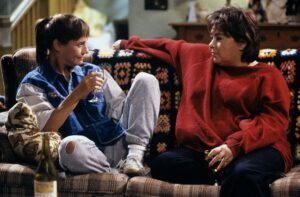
The Art of Nostalgia: How Roseanne’s Revival Brought the Conner Family Home to Life
When Roseanne made its long-anticipated return to television in 2018, fans were excited to catch up with the Conners and see their favorite characters back on screen. But for executive producers Tom Werner, Sara Gilbert, and Whitney Cummings, there was another equally important goal: bringing the iconic Conner home to life as authentically as possible. To make this vision a reality, they painstakingly recreated the set on Soundstage 15 in Studio City, California, focusing on every last detail, from the wallpaper to the props that had become so familiar to viewers. The result was an impressive homage to the original show, capturing the feel of the Conner home that was central to the show’s heart and humor.
Recreating a Home with Character

Production designer John Shaffner and his team took on the challenge of rebuilding the Conner home—a set that held deep meaning for both the actors and the audience. Over two decades after the original series ended, many of the original props and designs were no longer available, and Shaffner had to get creative to match the unique quirks of the Conner household. The wallpaper, for example, was no longer in print, and the team struggled to match the exact color palette. Gilbert, who had played Darlene since her teenage years, had a remarkably precise memory of the colors, which helped Shaffner’s team achieve the right look.
Bringing the Conner Living Room Back to Life
The living room, one of the most iconic spaces on the show, was recreated with extraordinary detail. While most viewers might not remember specifics like wall colors, Gilbert’s recollection helped guide Shaffner’s design. After some trial and error, they finally landed on a shade of “pale lettuce green” that matched the original. With that cornerstone in place, they continued to layer in the details that made the Conner living room feel like home.
One of the biggest challenges involved finding a couch that looked like the one audiences had grown so familiar with. While the original sofa still exists in an Arizona museum, renting it came with high demands. So, Shaffner’s team scoured Craigslist and eventually found two similar sofas. To replicate the classic Conner couch, they even went as far as buying fabric from a company specializing in RV upholstery, which they carefully customized to match the look of the original couch.
The Iconic Afghan and Coffee Table
For Shaffner, finding the perfect replica of the afghan blanket that draped over the Conner couch was easier than anticipated—they had a few duplicates from the original set. The coffee table, another memorable piece of the living room’s layout, was recreated with attention to every mark and scratch, preserving the character it had gained over the years. Each piece of furniture, from the couch to the worn coffee table, told a story and symbolized the lives and experiences of the Conner family.
A House Full of Memories

Adding family photos and nostalgic details was an essential part of making the Conner home feel complete. Shaffner’s team even managed to source old photos of cast members from the original show, placing pictures of characters like D.J., David, and Becky on the hallway walls to evoke a sense of continuity. Although the famous “dogs playing poker” picture, a beloved piece of the Conner household, couldn’t be recovered, the team went above and beyond to ensure that other familiar elements were present. They even returned a dinosaur figurine to its spot on the rear console, creating a space that felt like a snapshot of the Conners’ lives through the years.
New Additions Reflecting Realities of the Conners’ Lives
While many elements of the set were preserved as they originally were, some changes were made to reflect the passage of time. In the stairwell, for example, the production team installed a chair lift—an addition that symbolized the aging of Dan and Roseanne. This small detail not only offered a touch of humor but also reinforced the show’s dedication to portraying the realities of family life as characters grow older.
A Fireplace Built from Memory
One of the more challenging aspects of the project was recreating the fireplace, a centerpiece of the Conner living room. Since close-up shots of the fireplace were rare in the original show, Shaffner had to rely on old mockups from Garvin Eddy, the original production designer, to replicate it accurately. The mantel was originally sourced from Sears, but since that model was no longer available, Shaffner’s team reproduced it from scratch, down to the electric logs. Once the fireplace was reconstructed, Roseanne Barr herself suggested placing photos of the Conner matriarchs on the mantel, transforming it into a symbolic family shrine that would resonate with both the cast and the viewers.
A Dedication to Authenticity

For Shaffner, Werner, Gilbert, and the rest of the creative team, authenticity was the driving force behind every decision. They didn’t merely rebuild a set; they revived a piece of television history, capturing the essence of a working-class family home that audiences had come to love. Every paint choice, every piece of furniture, and every family photo was a labor of love that reflected the care and dedication of those who worked on the show. Their work paid off, with many fans and cast members describing the experience as akin to “coming home.” For John Goodman, who played Dan, walking onto the set was like stepping back in time. “It was like the last 20 years didn’t happen,” he recalled, describing the emotional impact of seeing the recreated set for the first time.
The Enduring Influence of Roseanne’s Set Design
The revival of Roseanne’s set underscored just how significant set design can be in shaping a show’s identity. The Conner home was more than just a backdrop; it was an extension of the characters, reflecting their values, struggles, and resilience. Through Shaffner’s work, the home maintained its sense of warmth and imperfection, symbolizing the Conners’ ongoing journey and inviting fans to share in their story once again.
By taking such care with the set design, the revival of Roseanne didn’t just honor the original show’s legacy—it strengthened it. The project illustrated how television has the power to capture real-life experiences and emotions, turning a fictional home into a place that feels undeniably real. The Roseanne revival’s success was due in no small part to this dedication to detail, as the Conner home became a character in its own right, symbolizing the strength and humor that defined the family at its heart. Through Shaffner and the team’s hard work, the Conners proved that, sometimes, you really can go home again.
